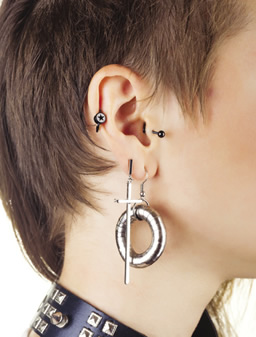Body Piercing and Electorcautery Risks
![]() Dear Q&A,
Dear Q&A,
It seems to me that I encounter more patients with all kinds of body piercing, and I am not exactly sure what the implications are if/when the surgeon plans to use electrocautery.

My (probably rather limited) understanding of this situation and my questions related to it are as follows:
1) Electrical current enters the patient’s body and leaves it via the grounding pad, because that is usually the path of least resistance. However, in patients who have earrings (or some other form of body piercing), the path of least resistance could be the path through the earring and the electrical current could cause a burn at that site. Is that correct?
Ursula Class, MD
Seattle Children’s Hospital
![]() Dear Dr. Class,
Dear Dr. Class,
You are basically correct. The return plate for the electrosurgical unit ESI (it is NOT a grounding pad) is a large surface area, low resistance pathway for the ESI energy to safely return to the machine. Normally the energy will not go through other pathways. However, there is always the danger, the electrolyte gel may be dried out, or the pad could be dislodged, and indeed piercings could act as a return pathway and cause a burn.
![]() Dear Q&A,
Dear Q&A,
2) Does taping the earring help in any way? If yes, how?
![]() Dear Dr. Class,
Dear Dr. Class,
No. It only helps to keep it from getting lost.
![]() Dear Q&A,
Dear Q&A,
3) Can a metal retractor act as a diverting medium also? And why is that usually not a problem? Does that have something to do with size, i.e., a certain amount of current delivered to a tiny earring can cause more harm than the same amount of current delivered to a relatively large retractor?
![]() Dear Dr. Class,
Dear Dr. Class,
Again, normally no problem; however, the retractor could conduct current. Many a surgeon has discovered a hole in their glove when they held a retractor and activated the ESI. Yeow! It is true the smaller the surface area the worse the burn.
![]() Dear Q&A,
Dear Q&A,
4) I probably have anesthetized many patients with earrings in place and only a piece of tape applied over them and never had any problems even though electrical cautery was used. Have I and my patients only been lucky?
![]() Dear Dr. Class,
Dear Dr. Class,
I think the safest thing is always to remove all piercings. If the system is working – no problem. The modern ESIs are better made than the older ones and the pads are much better. However, there is still a small risk.
I hope this helps.
Regards,
Jan Ehrenwerth, MD
![]() Dear Q&A,
Dear Q&A,
Thank you very much for your help!
The APSF Committee on Technology
Numerous questions to the Committee on Technology are individually and quickly answered each quarter by knowledgeable committee members. Many of those responses would be of value to the general readership, but are not suitable for the Dear SIRS column. Therefore, we have created this simple column to address the needs of our readership.
The information provided is for safety-related educational purposes only, and does not constitute medical or legal advice. Individual or group responses are only commentary, provided for purposes of education or discussion, and are neither statements of advice nor the opinions of the APSF. It is not the intention of the APSF to provide specific medical or legal advice or to endorse any specific views or recommendations in response to the inquiries posted. In no event shall the APSF be responsible or liable, directly or indirectly, for any damage or loss caused or alleged to be caused by or in connection with the reliance on any such information.


 Issue PDF
Issue PDF